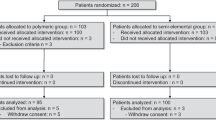Abstract
A comparative nutritional study in brain-injured patients (BIP) was performed to assess the influence of a combined enteral-parenteral nutrition (CN) and a total parenteral nutrition (TPN) on protein catabolism in the early posttraumatic period. 20 male BIP (Glasgow coma scale 5–7) were randomized to one of the two feeding regimes. Nutritional support was based on 150–175% basic energy expenditure. Amino acid intake was 1.4 g/kg/day in the TPN and 2.4 g/kg/day in the CN group. Negative nitrogen balance (NNB) averaged x (SEM=3.06 g/m2/day) in the TPN group and x (SEM=2.33 g/m2/day) in the CN group. Between both feeding regimes not statistically significant differences could be observed concerning mortality, N-balance, creatinine and 3-methylhistidine excretions. Protein concentration of the regurgitated gastric fluid was significantly higher in the CN than in the TPN study group. Data imply that both alimentary regimes are of similar value, but BIP with imparired gastric function, such as high tube reflux, are better treated by TPN.
Similar content being viewed by others
References
Adams S, Simonowitz D, Orescovic M, Barale K, Edwards W, Pallidar P, Duffy K (1983) Hyperalimentation of severely injured patients: parenteral versus enteral nutrition. 7th Clinical Congress of the American Society of Parenteral and Enteral Nutrition, Washington
Askanazi J, Carpentier YA, Elwyn DH, Nordenstrom J, Jeevanandam M, Rosenbaum SH, Gump FE, Kinney JM (1980) Influence of total parenteral nutrition on fuel utilization in injury and sepsis. Ann Surg 191:40
Birkhan RH, Long CL, Fitkins D, Geiger JW, Blackemore WS (1980) Effects of major skeletal trauma on whole body protein turn over in man, measured by 1(1,14C)-leucine. Surgery 88:294
Elwyn DH, Kinney JM, Jeevandam M, Gump FE, Broell JR (1979) Influence of increasing carbohydrate intake on glucose kinetics in injured patients. Ann Surg 190:117
Gazzaniga AB, Polachek JR, Wilson AF, Day AT (1978) Indirect calorimetry as a guide to caloric replacement during total parenteral nutrition. Am J Surg 136:128
Grünert A (1983) Stoffwechselbesonderheiten und parenterale Ernährung bei der Sepsis unter besonderer Berücksichtigung des Kohlenhydratstoffwechsels. Beitr Infusionstherapie Klin Ernähr 10:125
Hausmann D, Schulte am Esch J (1982) Zum Einfluß der Dexamethason-und Beatmungstherapie auf den Sondenreflux bei der kombinierten enteral-parenteralen Ernährung neurochirurgischer Intensivpatienten. Infusionstherapie 9:226
Hausmann D, Rommelsheim K, Josten KU, Mosebach KO, Caspari R, Lippoldt R (1983) Brain injured patients—the outcome one week after accident. Intensive Care Med 9:239
Iapichino G, Gattinoni L, Solca M, Radrizzani D, Zucchetti M, Langer M, Vesconi S (1982) Protein sparing and protein replacement in acutely injured patients during TPN with and without amino acid supply. Intensive Care Med 8:25
Jürgens P (1982) Der postoperative Aminosäurestoffwechsel. Infusionstherapie 9:74
Long CL, Schaffel N, Geiger JW, Schiller WR, Blakemore WS (1979) Metabolic response to injury and illness: estimation of energy and protein needs from indirect calorimetry and nitrogen balance. JPEN 3:452
Messing B, Pontal JP, Bernier JJ (1983) Metabolic study during cyclic total parenteral nutrition in adult patients with and without corticosteroid-induced hypercatabolism: comparison with standard total parenteral nutrition. JPEN 7:21
Roth E, Funovics J, Schulz F, Karner J (1980) Biochemische Methoden zur Bestimmung des klinischen Eiweißkatabolismus. Infusionstherapie 6:306
Rutten P, Blackburn GL, Flatt JP, Hallowell E, Cochran D (1975) Determination of optimal hyperalimentation infusion rate. J Surg Res 18:477
Sachs L (1978) Angewandte Statistik: statistische Methoden und ihre Anwendung, 5th edn. Springer, Berlin Heidelberg New York
Schmitz JE, Lotz P, Grünert A (1981) Untersuchungen über den Substrat- und Energieumsatz an langzeitbeatmeten Intensivpatienten. Infusionstherapie 8:61
Schmitz JE, Lotz P, Ahnefeld FW, Grünert A (1981) Untersuchungen sur Eiweiß- und Energieversorung von Intensivpatienten. Infusionstherapie 8:158
Schiller WR, Long CL, Blakemore WS (1979) Creatinine and nitrogen excretion in seriously ill and injured patietns. Surg Gynecol Obstet 149:561
Shenkin A (1979) Monitoring the nutritional status of critically ill patients. Intensive Care Med 5:165
Teasdale G, Jennett B (1974) Assessment of coma and impaired consciousness. Lancet 2:81
Twyman DL, Rapp RP, Young AB (1982) Parenteral vs enteral feedings in severe head injury patients, 6th Clinical Congress of the American Society of Parenteral and Enteral Nutr, San Francisco
Wolfe RR, Allsop JR, Burke JF (1979) Glucose metabolism in man: response to intravenous glucose infusion. Metabolism 28:210
Author information
Authors and Affiliations
Rights and permissions
About this article
Cite this article
Hausmann, D., Mosebach, K.O., Caspari, R. et al. Combined enteral-parenteral nutrition versus total parenteral nutrition in brain-injured patients. Intensive Care Med 11, 80–84 (1985). https://doi.org/10.1007/BF00254779
Accepted:
Issue Date:
DOI: https://doi.org/10.1007/BF00254779




